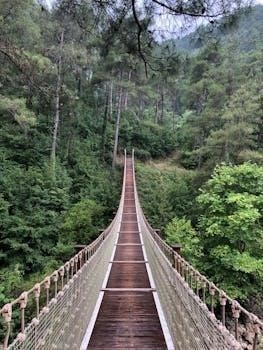Long Trail Map PDF⁚ An Overview
A Long Trail map PDF provides hikers with a convenient way to navigate Vermont’s challenging terrain. These digital maps offer detailed trail information, including shelters and peaks. Hikers can download them for offline use with apps like HiiKER, ensuring reliable navigation.

Importance of Detailed Maps for the Long Trail
Detailed maps are crucial for a safe and successful Long Trail hiking experience, ensuring hikers are well-prepared for the challenges of Vermont’s diverse terrain. These maps provide essential information that goes beyond basic trail routes, offering insights into elevation changes, shelter locations, water sources, and potential hazards. With a detailed map, hikers can effectively plan their daily goals, preventing accidental hikes up steep inclines and ensuring they reach their destinations safely.
The Long Trail, known as the “footpath in the wilderness,” presents a variety of natural features, including pristine ponds, alpine sedge, hardwood forests, and swift streams. Navigating these features requires a comprehensive understanding of the trail layout, which detailed maps provide. These maps allow hikers to anticipate changes in terrain, locate key landmarks, and make informed decisions about their route.
Moreover, detailed maps serve as a vital backup to digital navigation tools like the HiiKER app. While technology offers convenience, it’s essential to have a physical map and compass as a safeguard against unforeseen circumstances such as battery failure or signal loss. A detailed map ensures that hikers can continue their journey even when technology fails.
For those embarking on section hikes, detailed maps are invaluable for tracking progress and planning future segments. They allow hikers to mark completed sections, identify remaining challenges, and develop a strategic approach to completing the entire trail. Additionally, detailed maps often include helpful planning tools, such as mileage charts and campsite locations, which aid in organizing and executing a well-prepared hike.

Green Mountain Club Maps
The Green Mountain Club (GMC) offers a range of maps specifically designed for the Long Trail, providing hikers with reliable and detailed navigational resources. These maps are essential for anyone planning to explore Vermont’s iconic long-distance hiking trail, ensuring they have the necessary information for a safe and enjoyable experience. The GMC, dedicated to maintaining and protecting the Long Trail since 1910, has a long-standing tradition of producing high-quality maps tailored to the trail’s unique challenges.
One of the most popular options is the comprehensive Long Trail map, which covers the entire trail in a single sheet. While some hikers may worry about the level of detail in a single-sheet map, the GMC strives to provide a balance between coverage and clarity. For those seeking even greater detail, the GMC also offers sectional maps that break the trail into smaller, more manageable segments. These sectional maps provide enhanced topographical information, highlighting elevation changes, water sources, and shelter locations.
GMC maps are known for their accuracy and reliability, reflecting the club’s deep knowledge of the Long Trail. The maps are regularly updated to reflect changes in the trail, including reroutes, new shelter construction, and updated trail conditions. This commitment to accuracy ensures that hikers can rely on GMC maps for the most current information.
In addition to the standard paper maps, the GMC also offers waterproof versions, ideal for the unpredictable weather conditions often encountered in the Green Mountains. These waterproof maps provide added durability, ensuring they can withstand rain, snow, and other elements without deteriorating.
Beyond maps, the GMC webstore features a variety of guidebooks and other resources to help hikers plan their Long Trail adventures. These resources often complement the maps, providing additional information on trail history, natural features, and safety tips. By purchasing maps and guidebooks from the GMC, hikers directly support the club’s efforts to maintain and protect the Long Trail for future generations.

Digital Navigation with HiiKER App and Offline Maps
The HiiKER app has emerged as a valuable tool for hikers tackling the Long Trail, offering a modern and convenient approach to navigation. This app allows users to download trail maps for offline use, eliminating the reliance on cellular service and ensuring hikers can navigate even in remote areas of the Green Mountains. With the HiiKER app, hikers can access detailed topographic maps, track their location in real-time, and plan their route with waypoints and custom routes. This digital approach to navigation complements traditional paper maps, providing a backup and an alternative for hikers seeking a more interactive experience.
Offline maps are a crucial feature of the HiiKER app, allowing hikers to access essential navigational information without an internet connection. This is particularly important on the Long Trail, where cell service can be spotty or nonexistent in certain areas. By downloading maps in advance, hikers can ensure they always have access to trail information, regardless of their location.
The HiiKER app offers a range of features that enhance the hiking experience. Users can view elevation profiles, track their mileage, and record their hiking statistics. The app also allows hikers to share their location with friends and family, providing an added layer of safety. With the HiiKER PRO subscription, users can even print stages of the Long Trail using their home printer, creating customized paper maps for specific sections of the trail.
While digital navigation offers many advantages, it’s essential to remember that it should not be solely relied upon. Electronic devices can fail due to battery issues, damage, or technical glitches. Therefore, it is always wise to carry a compass and physical maps as a backup. Combining digital navigation with traditional map reading skills ensures hikers are prepared for any situation on the Long Trail.
The HiiKER app represents a significant advancement in hiking navigation, providing users with a powerful and convenient tool for exploring the Long Trail. By leveraging offline maps and a range of useful features, the app enhances the hiking experience and promotes safety on the trail. However, hikers should always exercise caution and supplement digital navigation with traditional map reading skills for a well-rounded approach.
Key Features of Long Trail Maps
Long Trail maps, whether in PDF or printed format, are essential tools for hikers, offering a wealth of information to navigate Vermont’s iconic footpath. These maps are meticulously designed to provide a clear and comprehensive representation of the trail, its surroundings, and key features that hikers need to be aware of. Several key features are consistently found across different Long Trail maps, ensuring hikers have the information required for a safe and enjoyable experience.
Detailed Topography⁚ A fundamental feature of any good Long Trail map is its detailed depiction of the terrain. Contour lines are used to represent elevation changes, allowing hikers to visualize the steepness of climbs and descents. This information is crucial for planning daily mileage and estimating hiking time. Maps often highlight significant peaks, valleys, and other topographic features, providing a comprehensive understanding of the landscape.
Trail Markings and Shelter Locations⁚ Long Trail maps clearly indicate the trail’s route, including its intersections with other trails and roads. They also show the locations of shelters, campsites, and water sources along the trail. This information is essential for planning overnight stays and resupplying with water. The maps typically use standardized symbols to represent these features, making them easy to identify.
Mileage and Elevation Profiles⁚ Most Long Trail maps include mileage markers along the trail, allowing hikers to track their progress and estimate distances between points. Some maps also provide elevation profiles, which show the elevation changes along the trail in a graphical format. This can be invaluable for assessing the difficulty of upcoming sections and managing energy levels.
Water Sources and Points of Interest⁚ Identifying reliable water sources is critical for any long-distance hike. Long Trail maps typically indicate the locations of streams, springs, and other water sources. They may also highlight points of interest along the trail, such as scenic overlooks, historical sites, and unique geological formations. This information can enhance the hiking experience and provide opportunities for exploration.
Safety Information⁚ Some Long Trail maps include safety information, such as warnings about hazardous areas, advice on dealing with wildlife, and emergency contact numbers. This information can help hikers make informed decisions and respond appropriately to potential risks.
By incorporating these key features, Long Trail maps empower hikers to navigate the trail confidently, plan their trips effectively, and enjoy the beauty and challenges of Vermont’s wilderness.

Long Trail Sections and Mileage
The Long Trail, Vermont’s iconic “footpath in the wilderness,” stretches 273 miles from the Massachusetts border to the Canadian border. To better manage and appreciate this extensive trail, it’s commonly divided into sections, each with its unique characteristics, challenges, and mileage. Understanding these sections is crucial for planning a thru-hike or shorter backpacking trips.
While there isn’t one universally agreed-upon segmentation, the Long Trail is often broken down based on geographical features, access points, or the presence of shelters and facilities. The Green Mountain Club (GMC), the primary organization responsible for maintaining the Long Trail, provides maps and guidebooks that typically divide the trail into manageable sections.
Southern Section (Massachusetts Border to Route 4)⁚ This section is approximately 48 miles long and shares its path with the Appalachian Trail for about 100 miles. It’s characterized by gentler terrain and lower elevations compared to the northern sections. Key features include Glastenbury Mountain and Stratton Mountain. The shared section with the AT can be busy, especially during peak hiking season.
Central Section (Route 4 to Route 17)⁚ Spanning roughly 68 miles, this section presents a mix of challenging climbs and rewarding views. Hikers encounter Killington Peak, the second-highest mountain in Vermont, and traverse through the Green Mountain National Forest. This section offers a good balance of solitude and accessibility.
Northern Section (Route 17 to Route 118)⁚ This section is approximately 75 miles long and is known for its rugged terrain and remote wilderness. Hikers face steep ascents and descents, navigate rocky ridgelines, and cross several challenging gaps. Key features include Camel’s Hump, one of Vermont’s most iconic peaks, and the Worcester Range.
Northeastern Section (Route 118 to Canadian Border)⁚ This final section, about 82 miles, is the most remote and challenging part of the Long Trail. It features dense forests, numerous water crossings, and steep climbs over exposed summits. Jay Peak, known for its ski resort, is a prominent landmark in this section. The terrain is often muddy and overgrown, requiring careful navigation.
The mileage provided for each section is approximate and can vary slightly depending on the source. It’s essential to consult official GMC maps and guidebooks for the most accurate information. When planning a hike, consider the elevation gain and loss in each section, as this can significantly impact the difficulty and duration of the trip.
By understanding the different sections and their respective mileage, hikers can effectively plan their Long Trail adventure, whether it’s a day hike, a multi-day backpacking trip, or a full thru-hike.
OpenStreetMap and the Long Trail
OpenStreetMap (OSM) is a collaborative, open-source project that aims to create a free, editable map of the world. Think of it as Wikipedia, but for maps. The data is contributed by a global community of mappers who use GPS devices, aerial imagery, and local knowledge to create a detailed and up-to-date representation of the Earth’s surface. This includes trails, roads, buildings, and other features. The Long Trail, Vermont’s renowned hiking trail, is increasingly well-represented on OpenStreetMap, offering hikers a valuable resource for planning and navigation.
The beauty of OpenStreetMap lies in its community-driven nature. Anyone can contribute to the map, adding or correcting information as needed. This means that the data is constantly evolving and improving, often reflecting the most current conditions on the ground. For the Long Trail, this translates to accurate trail routing, updated shelter locations, and detailed information about water sources and other points of interest.
Hikers can access OpenStreetMap data in various ways. Numerous apps and websites utilize OSM data to provide interactive maps for navigation. These apps often allow users to download map data for offline use, which is crucial for hiking in areas with limited or no cell service. By downloading an offline map based on OpenStreetMap, hikers can confidently navigate the Long Trail without relying on a cellular connection.
Furthermore, OpenStreetMap data can be used to create custom maps for printing. Hikers can select specific sections of the Long Trail, customize the map’s appearance, and generate a PDF file for printing. This allows for a personalized paper map that complements digital navigation tools.
However, it’s important to remember that OpenStreetMap is a community-driven project, and the accuracy of the data can vary. While many sections of the Long Trail are meticulously mapped, others may have outdated or incomplete information. It’s always a good idea to cross-reference OSM data with other reliable sources, such as the Green Mountain Club’s official maps and guidebooks;
Despite its potential limitations, OpenStreetMap offers significant advantages for Long Trail hikers. Its open-source nature allows for continuous improvement and customization, and its widespread availability makes it a valuable tool for planning and navigating this iconic trail. By combining OpenStreetMap data with other resources and exercising good judgment, hikers can enhance their Long Trail experience.
